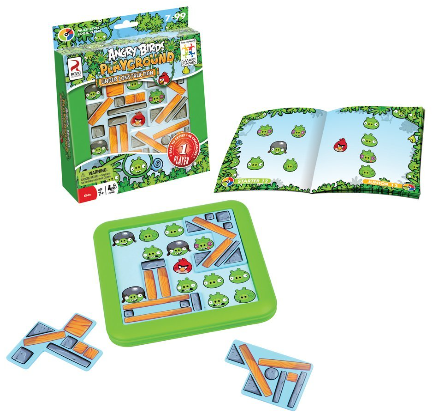 |
| Angry Birds Playground Under Construction |
With only 4 pieces, how hard can it be? Plenty. The plastic puzzle board has 20 unmovable birds that are printed on it. The plastic puzzle pieces are printed as shown above, to look like pieces of wood and stone.
To play, choose a challenge from the puzzle book. Puzzles are in order of difficulty from easiest to most difficult and the answers are in the back. Your job is to use the four puzzle pieces to cover all birds on the board except the bird pictures that are showing on the puzzle you chose. The positions that the birds are pictured in on the challenges are not where they will appear on the puzzle. The pictures are just to show you which birds not to cover. Puzzles range from Starter to Master, and Master puzzles may take awhile to work out.
If you are interested in reading more about this type of logic puzzle, check out my post What's in Your Therapy Box? Logic Puzzles Edition.
Try this:
- Give the location of one piece and let the individual find the rest. FYI: Once one piece is given, the other three pieces often fall right into place.
- Start with three pieces already in place. Let the individual place the fourth. Then start a puzzle with two pieces already in place and let the individual finish it. Then one piece, until the individual is working independently.
- Work several puzzles. If the individual is struggling, use those same puzzles the next time you work and see if the individual remembered how to solve. If not, keep coming back to the same puzzles until they are solvable before going on to harder ones.
- Solve a puzzle as the individual watches. Problem solve aloud so that the individual can learn how to solve the puzzle. Then take the pieces out and ask the individual to solve the same puzzle.
- Offer a clue as to whether each piece is on the top or bottom of the puzzle.
- Look at a piece and then at the empty space. Try to determine whether that shape can actually fit into the space before trying it. Some individuals will waste time trying pieces in spaces that are not big enough or the correct shape. Teach them to determine that before trying the piece if possible.
- Explain that these types of puzzles often take a certain amount of trial and error and that getting it wrong is not failure, just keep trying until something works.
- Demonstrate how turning a piece in different directions can make it look different.
- Use the answer part of the book and use the puzzles as patterns for set up only if the individual is not capable of solving the puzzles.
- Work on visual discrimination, spatial relations, visual closure, figure ground, visualization, visual form constancy, eye-hand coordination, in-hand manipulation, manual dexterity, executive functioning skills, process skills, play and leisure exploration and participationIn the box: Plastic puzzle board, 4 plastic puzzle pieces, puzzle book with 48 challenges
If you are interested in purchasing this game or just want more information, click on the link below to go to Amazon.com.



No comments:
Post a Comment
Thank you for taking the time to comment.